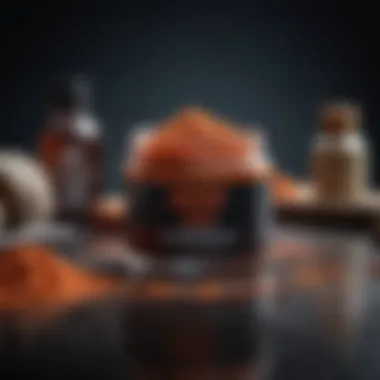Expert Techniques for Dip Powder Nail Removal


Intro
In recent years, dip powder nails have gained immense popularity, celebrated for their durability and vibrant colors. However, improper removal of dip powder can lead to damaged nails and compromised nail health. It is crucial for individuals who frequently indulge in this beauty trend to understand the best practices for removal. This guide aims to explore effective techniques, essential tools, and valuable tips for maintaining nail integrity after dip powder application. By diving into the world of dip powder removal, readers can enhance their knowledge and ensure a safer nail care routine.
Understanding the significance of proper removal techniques is foundational. The process not only preserves the condition of natural nails but also helps avoid unsightly lifting or breakage. Whether you are a seasoned nail enthusiast or a novice looking to learn, this article provides everything needed for responsible dip powder maintenance.
"Proper removal is just as important as the application of dip powder nails."
From popular methods to aftercare advice, this comprehensive guide unfolds in the following sections.
Understanding Dip Powder Nails
Understanding dip powder nails is fundamental to grasping effective removal techniques. This knowledge helps individuals recognize what makes dip powder an appealing choice for their nail care routine, while also informing them of the considerations that accompany its application and removal. Knowledge of dip powder nails forms the foundation for maintaining healthy nails and making smart decisions about nail enhancements.
What Are Dip Powder Nails?
Dip powder nails are a type of manicure that combines a powdered acrylic mixture and a bonding solution. The process of application involves dipping the nails into colored powder, followed by sealing them with a top coat. This method offers a strong, durable finish that can last several weeks without chipping or fading. Unlike traditional nail polish, which requires dry time and regular touch-ups, dip powder creations provide a more resilient alternative, making them a favored option among many.
Benefits of Dip Powder Nails
Dip powder nails present several noteworthy advantages:
- Longevity: They often can last up to three weeks or more if applied properly.
- Durability: Dip powder formulations create a tough layer over the nails, reducing the risk of breakage.
- Quick application: The dipping process allows for faster application compared to traditional methods.
- Variety of colors: Users often appreciate the vast color selection and the ability to customize designs easily.
These benefits contribute to dip powder nails being seen as a preferable choice for many women seeking both aesthetics and functionality in their nail care routine.
Common Concerns Regarding Dip Powder
Despite their growing popularity, dip powder nails are not without controversy. Common concerns include:
- Damage to natural nails: The removal process can be harsh if not done correctly, potentially leading to weakened nails.
- Allergic reactions: Some individuals may react to ingredients found in dip powders or bonding agents.
- Hygiene: There are concerns about the cleaning process of dip powder stations, which can pose risks if proper hygiene measures are not in place.
Given these concerns, understanding the implications of using dip powder nails is crucial for making informed decisions on treatments and removal techniques.
Signs That Dip Powder Removal is Necessary
Understanding when to remove dip powder nails is crucial for maintaining the health of your nails and overall aesthetic. Dip powder is a popular choice for its durability and long-lasting finish; however, as time passes, the necessity for removal arises. Recognizing the signs for removal helps in avoiding complications that might lead to nail damage.
When to Remove Dip Powder
Dip powder nails should be removed when they begin to look worn or damaged. Regular upkeep is essential to prevent potential issues.
- Time Frame: As a general rule, consider removing dip powder every three to four weeks. This allows for proper nail health and prevents excessive buildup.
- Growth: If your natural nails are growing out underneath, the contrast can cause an unsightly appearance.
- Chips and Cracks: Observe for any chipping or cracks. Once these precipitate, the structural integrity of the nail is compromised.
By keeping an eye on growth and wear, you can extend the life of both your nails and the dip powder application.
Indicators of Damage or Wear
Several indicators can signal that it's time to consider dip powder removal. Pay attention to these signs:
- Discoloration: Changes in color may indicate staining or damage from the dip powder. If the nails start to look dull or yellowish, removal is advisable.
- Peeling: If the dip powder begins to peel away from your natural nails, this is a clear sign that the product is not adhering as intended.
- Brittleness: Dull or overly brittle nails can indicate that your nails are not healthy and are in need of a break. Strong dip powder applications can sometimes trap moisture, leading to weakening of the natural nail.
"Ignoring the signs can lead to irreversible damage. It is better to be proactive when it comes to nail care."
Being observant and responsive to these indicators can help prevent long-term complications, safeguarding your nails during every dip powder application.
Preparation for Dip Powder Removal
Preparing for dip powder removal is crucial for achieving optimal results. A careful and methodical approach can minimize damage to your nails and cuticles while ensuring an even and effective removal process. Consider the environment and tools used as these play a significant role in the overall experience.
Tools Needed for Removal


Gathering the right tools will make the removal process smoother and less stressful. Here is a breakdown of the essential items:
Nail file
Nail files are indispensable for dip powder removal. They help gently shape your nails and remove any excess product before soaking. A good nail file typically offers a range of grits to cater to different nail types. Its durability is a noticeable trait, making it a reliable choice throughout the removal process. However, improper use can lead to damaged nails if too abrasive a grit is employed.
Acetone
Acetone is widely recognized for its potent properties in dissolving dip powder. It works by breaking down the chemical bonds within the powder, making it easier to remove. The effective nature of acetone allows it to expedite the removal process. On the downside, acetone can dry out nails and skin if not paired with appropriate aftercare. Therefore, it is advisable to use it sparingly and with caution.
Cotton balls or pads
Cotton balls or pads are necessary to apply acetone and absorb the dissolved powder. Their soft texture helps to ensure a gentle application, minimizing potential trauma to the nails and surrounding skin. They are easy to use and dispose of, which makes them an appealing choice. Nevertheless, not all cotton pads are equally absorbent, and using less effective ones may lead to wasted acetone and longer removal times.
Nail buffer
Nail buffers play an important role in smoothing out the surface of the nails after the dip powder is removed. A quality buffer has multiple sides with varying levels of grit for different functions. It is vital for restoring the nails’ health and shine. However, excessive buffing can lead to thinning the nails, hence moderation is key.
Cuticle oil
Cuticle oil proves essential in promoting nail health post-removal. Its moisturizing properties help to replenish lost hydration, combating the dryness often caused by acetone. Choosing a nourishing cuticle oil can enhance the overall appearance of your nails. While there are many good quality cuticle oils on the market, sourcing one with rich, natural ingredients is preferable for optimal results.
Setting Up a Removal Station
Creating an efficient removal station is essential for a successful dip powder removal experience. An organized setup includes locating all gathered tools within reach. Consider using a flat, clean surface, like a table or desk, to lay out your materials. Ensure good lighting as well, as proper visibility will help you manage each step with care and precision. An organized workspace can significantly enhance your concentration and effectiveness during the process.
Methods for Dip Powder Removal
The removal of dip powder nails requires attention to various methods that each have their own degree of effectiveness. Understanding these methods helps in determining which is suitable for your needs. Different techniques impact the health of your nails post-removal, and some methods may even yield quicker results. It's also important to consider your level of comfort and experience when choosing a method, as some may be best performed by professionals.
Soaking Method
Step-by-step soaking process
The soaking method is straightforward and often used for removing dip powder. This method relies significantly on acetone, which breaks down the powder effectively. Here is the step-by-step process:
- Gather your materials: acetone, cotton balls or pads, and aluminum foil.
- Soak the cotton in acetone.
- Place the soaked cotton on your nail.
- Wrap each finger in aluminum foil to secure the cotton.
- Wait for 10 to 15 minutes.
- Gently remove the foil and cotton—most of the powder should lift off.
- Use a gentle nail buffer to smooth the nail surface.
The key characteristic of the soaking process is its simplicity. This method is known for necessitating minimal tools compared to others. However, the soaking process does require patience and time, as significant soaking may be needed for tougher layers of product.
Pros and cons of the soaking method
The pros of the soaking method include its efficiency in breaking down dip powder, resulting in minimal damage if done correctly. Equally, it is easily manageable at home, requiring only basic supplies. However, there are cons, as prolonged soaking can lead to dry nails or cuticles, making it essential to follow up with moisturizing agents.
Filing Method
Step-by-step filing process
Using a filing method can serve as an alternative to soaking, specifically for individuals more comfortable with manual techniques. In this approach, one can follow these steps:
- Start with a coarse nail file to gently file down the dip powder.
- Create an even surface by utilizing a buffer to smooth any rough areas.
- Once the bulk of the product is removed, switch to a finer file and buff once more.
- Clean your nails with a damp cloth to remove any residue.
This method effectively removes dip powder but takes more physical effort and may need practice to master. It is preferred by those who want an immediate sense of control over the removal process.
Pros and cons of the filing method
There are advantages to the filing method; it can be quite effective if executed correctly. The main appeal is the lack of reliance on acetone, which some people prefer to avoid. Conversely, the complexity of this method can lead to inadvertent damage if not careful. The risk of over-filing exists, which may weaken the natural nail structure a bit.
Combination Method
Integrating soaking and filing steps
Combining both soaking and filing methods presents a holistic approach to dip powder removal. Start with the soaking process to loosen up the product, then proceed to file and smooth any residues left behind. This dual approach can significantly reduce the risk of damaging the nails while ensuring complete removal of dip powder.


Pros and cons of the combination method
The primary advantage of the combination method lies in its comprehensive nature. By utilizing both techniques, you can achieve better final results—removing debris and ensuring nail health. However, this method requires the right timing. Too much soaking prior to filing could harm the nail structure, and insufficient soaking might result in incomplete removal leaving behind remnants of powder.
Post-Removal Care
Post-removal care plays a critical role in maintaining the health and appearance of your nails after dip powder removal. The process of removing dip powder can leave nails feeling vulnerable and sometimes damaged. Therefore, the focus should quickly shift to how to restore and revitalize them. Proper care helps in avoiding further weakening or potential infection.
Nail Health Tips
Hydration techniques
Hydration techniques are essential as they aim to restore moisture after the drying effects of acetone or filing. This is especially important because nails can become brittle without adequate hydration. Regular use of cuticle oil and moisturizers can greatly contribute to reversing damage. Hydrating the nails keeps them flexible and reduces the chances of cracking.
The key characteristic of this technique is its simplicity. Just a few drops of oil every day can make a big difference. One popular option is jojoba oil, known for its compatibility with the skin. The unique feature of jojoba is its similarity to natural sebum, making it an effective moisturizer. While advantageous, it is important to keep in mind that over-application can lead to greasiness.
Importance of cuticle care
Cuticle care deserves special attention as cuticles protect the nail matrix from infections. Neglecting them can result in damage or even painful conditions such as hangnails. Regular maintenance of cuticles also enhances the overall appearance of nails. The key aspect of cuticle care is consistency. Using cuticle oils or creams regularly can help protect them.
What sets cuticle care apart is its long-term benefits. Healthy cuticles promote nail growth while an unkempt cuticle can lead to various complications. While some may choose to push back cuticles, it is crucial to do so gently to prevent injury.
Choosing the Right Products
Choosing the right products is crucial for effective post-removal care. Not all products nurture nails equally. Understanding what works best for your nails can lead to improved health and resilience.
Nourishing oils and serums
Nourishing oils and serums are specifically formulated to repair and rejuvenate nails. They penetrate deeply, providing essential nutrients that support growth and strength. Many oils, like argan oil or vitamin E oil, are fantastic choices for enhancing nail health.
Their key characteristic is their ability to absorb quickly, delivering hydration without leaving residues. They are a popular choice for those looking to restore damaged nails. However, one disadvantage is that users need to allow time for absorption to fully reap the benefits.
Protective top coats
Protective top coats serve as a barrier against harmful elements that can weaken nails. They form a protective layer over the surface, reducing the risk of chips and breaks. Applying a top coat can significantly improve the longevity of nail polish as well, offering practical advantages.
What makes protective top coats essential is their versatility. A quality top coat can preserve the shine of your color while acting as a safeguard. The significant drawback could be that not all top coats are created equal, so choosing a high-quality product is important.
Regular post-removal care is not just about aesthetics; it contributes to the long-term health of your nails.
Risks and Precautions
Understanding the risks involved in dip powder removal is essential. This knowledge not only protects your nails but also enhances the overall nail care experience. Improper removal can lead to various issues, including nail damage, irritation, and unsightly results. Thus, being aware of the different risks allows you to take the necessary precautions to preserve the health of your nails. The choices made during this process can significantly affect the outcome.
Potential Risks of Improper Removal
Improper removal of dip powder nails can lead to several adverse effects:
- Nail Damage:
- Skin Irritation:
- Infection Risks:
- Unfinished Removal:
- Peeling and chipping can occur if not done correctly. The nail bed may weaken over time.
- Excessive filing or scraping may lead to thin, fragile nails.
- During removal, the use of harsh chemicals can irritate the surrounding skin and cuticles.
- Allergic reactions may happen, especially with acetone.
- If the nail is damaged or the skin around it is compromised, there is a higher chance of infections occurring.
- Bacteria may enter through open wounds or damaged skin.
- Not fully removing dip powder can lead to buildup, which can become unsightly and unhealthy over time.
- Uneven nails may develop, affecting the aesthetic quality of your nails.
"Taking the right precautions during removal ensures your nails remain healthy and strong, fostering an effective nail care routine".
Best Practices for Safe Removal
To avoid the risks associated with dip powder removal, safe practices are essential. Here are some recommendations:


- Choose Quality Products:
- Limit Exposure to Chemicals:
- Proper Tools:
- Gentle Techniques:
- Aftercare:
- Use high-quality acetone to ensure effective and gentle removal. Look for skincare-friendly options.
- Minimize direct contact with harsh chemicals. Consider using gloves when handling acetone.
- Use a nail file specifically designed for dip powder removal. Avoid tools that might cause unnecessary trauma to your nails.
- Use a soaking method if you prefer a more gradual approach, as it tends to be less aggressive than filing.
- File gently and avoid the nail bed to prevent long-term damage.
- Always follow up with nourishing oils and creams after removal to hydrate and protect your nails.
Implementing these best practices will help you minimize risks and maintain the integrity of your nails.
Professional Help vs. DIY Removal
When it comes to dip powder removal, one must weigh several factors to decide between professional help or attempting to do it at home. Both options come with distinct advantages and potential downsides. Making the right choice can lead to better results and healthier nails.
Important Elements to Consider: There are various reasons one might choose professional help over a DIY approach. For instance, if there's extensive damage from previous applications or underlying nail health issues, a trained professional is better equipped to manage the situation. Professionals have the tools and training to ensure a safe removal process. In addition, a salon can provide immediate results which may be more difficult at home, especially for intricate designs or stubborn pigments.
Conversely, DIY removal can be a practical and cost-saving option. It offers flexibility in terms of timing and comfort of home. Many women turn to at-home techniques to maintain their nail health without the expense associated with regular salon visits. However, this comes with its own risks if proper procedures are not followed.
"Understanding the balance between professional help and DIY removal is key to maintaining nail health. Always consider the condition of your nails before deciding your course of action."
Here are some benefits and considerations for both choices:
Benefits of Professional Help:
- Expertise: Trained nail technicians understand the nuances of nail health and can handle complex situations.
- Tools and Products: Salons have professional-grade products that can provide high-quality results.
- Time Saved: Professionals often complete the removal process more quickly than a novice might at home.
Considerations for DIY Removal:
- Cost-Effective: Performing removal at home does not incur salon fees.
- Flexibility: You can choose when to do your nails without needing an appointment.
- Learning Opportunity: DIY removal allows one to understand their nails better and become more skilled over time.
When to Seek Professional Help
Professional help is advisable under certain circumstances. If you notice persistent discomfort or if your nails are breaking more frequently, seeking a professional can provide immediate solutions. Additionally, if you are unsure about the removal techniques or feel overwhelmed, salons can offer secured and accurate methodologies. Some signs indicating the need for professional help include:
- Unusual nail texture or appearance
- Pain or soreness around the nail area
- Multiple layers of dip powder leading to complications in removal
Evaluating DIY vs. Salon Removal
When evaluating whether to go the DIY route or to head to a salon, you should assess not just the condition of your nails, but also your own comfort level with the tools and processes needed for removal. Ask yourself:
- Do I have the proper tools at home?
- Am I skilled enough to perform the removal safely?
- What is the current state of my nails?
If you feel that undertaking the removal process might risk damaging your nails or if you have had difficulties in the past, the salon option may be the better choice. Alternatively, if you feel confident and prepared, a DIY removal can be just as effective. Your final choice should reflect your nail conditions, available resources, and personal preferences.
The End
The conclusion of this article serves as an essential recap, emphasizing the significance of proper dip powder nail removal techniques. Understanding how to effectively remove dip powder nails is crucial for maintaining nail health and preventing damage. Many users often neglect the right removal methods, leading to weakened nails and various complications.
In this section, we'll highlight the key points discussed previously and offer insights into best practices for users looking to transition between different nail styles without compromising the integrity of their nails. The article seeks to empower readers by providing detailed information, from identifying when to remove dip powder nails to choosing safe removal methods.
Summarizing Key Points
Throughout the article, several crucial aspects have been explored regarding dip powder removal:
- Importance of Proper Tools: Using the right tools, such as acetone, cotton balls, nail files, and buffers, is fundamental for an effective removal process. Each tool serves a specific purpose that aids in minimizing damage while removing the material.
- Method Selection: Three primary methods for removing dip powder nails have been outlined: soaking, filing, and a combination of both. Each technique has its advantages and drawbacks, allowing individuals to choose based on their comfort and nail condition.
- Post-Removal Care: Aftercare is essential. Hydrating nails and cuticles is a must to restore them to a healthy state. Choosing the right nourishing products will also help in maintaining overall nail health.
- Risks and Precautions: Highlighting potential risks during the removal process makes users aware of the need for care. Best practices should always be followed to avoid harmful effects on the nails.
- Seeking Professional Help: Knowing when to reach out to professionals is invaluable. Not every removal process can or should be performed at home. There are instances when professional assistance is required for optimal nail health.
Empowering Choices in Nail Care
In empowering choices in nail care, this article provides readers with the knowledge necessary to make informed decisions. Understanding the importance of proper dip powder removal encourages individuals to take proactive steps toward maintaining healthy nails.
By utilizing the tools and methods discussed, users can adopt a balanced approach to nail care. This knowledge allows them to:
- Choose the method that suits their comfort level and desired results.
- Recognize the signs of wear or damage that warrant immediate removal.
- Implement effective aftercare practices that ensure nail recovery.
- Make educated decisions regarding professional help versus DIY solutions, optimizing their experience.
Ultimately, being well-informed leads to healthier nails and enhances the joy of personal grooming. Readers are now equipped to embrace their nail care journey with confidence.



